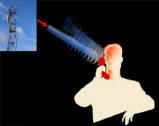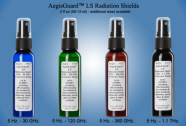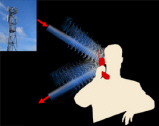
| Cell Phone Radiation FAQ's |
|
|||
 |
 |
 |
|
| Without
AegisGuard™ LS |
AegisGuard™ LS For Wireless Products & Networks |
With AegisGuard™ LS |
|
| Are wireless phones a health threat? | ||||||
| What health problems have been reported by wireless phone users? | ||||||
| Do government authorities and mobile phone manufactures say they are safe? | ||||||
| What is SAR and SAR testing? | ||||||
| What about Hands-Free headsets? | ||||||
| Does cell phone radiation exposure increase in an automobile? | ||||||
| Are other people exposed to radiation from my wireless product? | ||||||
| Are all cell phones, and other wireless products and networks, including IoT, a health risk? | ||||||
| Do radiation levels vary between different parts of a cellular phone? | ||||||
| What should I consider when buying a radiation shield? | ||||||
| Which AegisGuard Radiation Shield should I use with my cell phone, or other wireless product? | ||||||
| How do I know AegisGuard Radiation Shields really work? | ||||||
| Will AegisGuard Radiation Shields affect my reception or battery life? | ||||||
| See Wireless RF Controversy for additional information. | ||||||
|
Are wireless phones a health threat? Yes. As a company involved with the radiation issues associated with wireless and laser products since 1984, and just like the scientists and engineers around the world who are debating this important question, we know that wireless radiation frequencies penetrate the head and body, increasing the temperature (SAR thermal level) of the brain and other body organs while the phone is in use. Discoveries published since 1999, however, confirm it also affects protective biological mechanisms in the body far below the thermal level, and it is extremely important to recognize that none of the numerous health risks attributed to wireless phone radiation are thermally induced. See Computer Generated Images for illustrations of phone radiation entering the body. While some have categorically stated there is no danger if phones are compliant with the SAR standards being disputed, others have referred to specific cases to illustrate the hazards and justify their conclusions. The number of phone radiation related incidents being reported and manufacturers applying for patents that include components designed to reduce the health risks clearly indicates there is a risk. As a manufacturer of laser products, we know that laser warning labels are mandatory in many nations when the output power exceeds 1mW, and in November, 1997, the United Kingdom banned class 3a laser pointers (above 1mW) from commercial sale. Yet mobile phones, all of which have an output power hundreds of times greater than our laser products, do not require warning labels. For additional information, review some of the News Articles and Radiation Links that present both sides of this controversy, or click here for a summary of the reported health symptoms and diseases attributed to cellular phone usage. |
||||||
| What health problems have been reported
by wireless phone users? Frequently symptoms and diseases reported to physicians and mobile phone manufacturers include several types of cancer, headaches, vision and hearing difficulties, increased ear and facial temperatures, nausea, dizziness, tingling sensations on the skin, and numbness or irritation to the face and neck. Some studies have presented evidence that blood pressure increases when a using a mobile phone, and there has been litigation over cancer and brain tumors allegedly caused by mobile phone radiation. Click here to see a list of more than 50 heath disorders attributed to wireless phone radiation. |
||||||
|
Do government authorities and mobile phone
manufactures say they are safe? Regulatory agencies, phone manufacturers and manufacturers have never said they are safe, and although the FDA was the first regulatory agency to admit they did not know if wireless products are safe, it appears they actually knew otherwise. All regulatory agencies state wireless products are compliant with published safety regulations and specifications, however the specifications and associated test procedures have created many debates. These organizations continue to spend millions of dollars testing the effects of mobile phone radiation, with many studies funded by phone manufacturers. Wireless phones are unusual because they are the only radiation producing consumer product that people intentionally place against their head and body for an extended amount of time. Since adequate testing and research typically requires years to complete, the rapidly changing technology makes it impossible for these organizations to publish their findings before the products being tested become obsolete. Moreover, there is no test equipment available that can measure the effects of radiation frequencies upon the body, including those generated by pulsed frequency modulation schemes incorporated into newer technologies. Many cell phone manufacturers were contacted for information about the radiation levels and overall safety of their products. The responses from those that responded were similar to the one presented below, which was received from an American manufacturer on March 17, 1998. The manufacturers name (xxx), model number (yyy), specifications (zzz) and sales information are omitted.
|
||||||
|
What is SAR and SAR testing? SAR guidelines call for testing distances less than 20 centimeters (approximately 7.8 inches) for compliance. Thermal measurements are derived by inserting a probe into a plastic head filled with liquid and recording the results. Real life body temperatures using these methods would obviously vary according to body size, weight, etc., however this not considered. See SAR Fallacy for additional information. SAR tests only measure the thermal effects (heat) of radiation for brief periods which are significantly lower than actual usage, or exposure, to wireless products and networks. Live testing cannot be performed because a probe would have to be inserted into the head of a person during exposure, such as during a cell phone call, to derive accurate thermal results. The irony is that none of the health effects attributed to wireless radiation is thermally induced or exacerbated. For obvious reasons, SAR test results presented to the public are based upon human head models with thermal tissue simulations, computer models or by other means where the results are estimated. According to Mobile Phone News, the President of Arpel Laboratories, a well respected and leading independent SAR testing laboratory, said "the methodology is very ambiguous," and their Chairman stated "computation may provide a different outcome than real measurement because it involves simulation of the handset". SAR test results for radiation shielding products are normally presented as a percentage of shielding effectiveness compared to the standards adopted by the FCC and other organizations. These standards remain controversial and continue to be the basis for many debates, particularly when one considers that SAR tests do not measure or otherwise consider the effects of radiation below what can be measured at the thermal level. Many mobile phones emit radiation close to the maximum approved SAR levels when used in environments without obstructions, and the radiation increases in poor reception areas. There has been considerable public disagreement about the effectiveness of SAR exposure limits and guidelines proposed by the FCC in 1993 and adopted in 1996. These guidelines are used to regulate phone radiation levels and incorporate many of the standards adopted by the Institute of Electrical and Electronics Engineers (IEEE) in 1991, and the American National Standards Institute (ANSI) in 1992. When the proceedings were held in 1996 to review the FCC guidelines, agencies such as the FDA did not agree that the proposed guidelines "for radiated power were sufficient to guarantee compliance with SAR limits." The FDA findings were presented in a letter to the Subcommittee on Telecommunications, Trade, and Consumer Protection of the United States House of Representatives on May 5, 1997. These considerations, combined with evidence that phone radiation affects protective biological mechanisms in the body far below what can be measured at the thermal level, clearly demonstrates that SAR test procedures do not reflect the actual effects of radiation on the human body. For these reasons, all AegisGuard Tests measure actual radiation frequencies with, and without, AegisGuard Shields installed using globally recognized ASTM (American Society of Testing and Materials) D4935-99, Mil-STD-285 and IEEE-STD-299 test standards and procedures. |
||||||
|
What about Hands-Free headsets? Headsets allow you to use a phone without placing it against your head, and most people attach the phone to their belt, briefcase or purse using a belt clip or other mounting device. Radiation penetrates areas such as the liver, kidneys, waist, groin and hip when using a belt clip and enters the ear canal directly from the headset. The media published studies in 1998 advising that pregnant women should not use cellular phones because of the risk to unborn embryos. During May, 1999, similar reports were released citing increased risks for men and women who use hands-free kits. These reports addressed concerns about the radiation emitted by the wire between the phone and headset, and emissions from the earpiece directly into the ear canal. Wireless headsets use a technology that replaces the headset wire with an additional transmitter and receiver and may prove to represent a greater health risk than wireless phones. In July, 1999, the London Sunday Mirror published the results of a study they commissioned about hands free kits, and a new element was added to the phone radiation controversy. The study revealed phones operate at higher power levels when they are held lower than the head, thus generating more radiation. Tests performed on a dummy torso filled with chemicals designed to imitate the human body displayed areas surrounding the liver and kidneys being flooded with energy. During December, 2000, the British government distributed leaflets throughout the United Kingdom addressing the health risks of mobile phone radiation and reversed their health approval recommendation advising consumers to use hands-free headsets after a number of investigations revealed they channeled radiation into the head. The headset recommendation reversal occurred after the British government commissioned SAR tests showing headsets reduce radiation and provided credence to the debate over SAR standards and test procedures being flawed. Click here for information about AegisGuard™ Headset Radiation Shields for wired and air tube headsets. Use AegisGuard™ LS Radiation Shields with wireless headsets. |
||||||
|
Does cell phone radiation exposure increase in an
automobile? One of the greatest dangers in an automobile is when a driver pays more attention to the phone than their driving. Many nations require hands-free car kits for mobile phone usage in automobiles, and it expected that other countries will pass similar legislation over the next few years. Ironically, headsets can be more dangerous than using a phone. |
||||||
|
Are other people exposed to radiation from my
wireless product? |
||||||
|
Are
all cell phones, and other wireless products and networks, including IoT,
a health risk?? |
||||||
|
Do radiation levels vary between different
parts of a cellular phone? Radiation frequencies are emitted from the entire phone, with the highest level being generated by the radio system (transmitter and receiver), the internal antenna system, the earpiece, display and keypad. This is why shielding devices that are designed to cover only a small portion of the phone are ineffective. Click here for additional information. |
||||||
|
What should I consider when buying a radiation shield? Review the test results and claims made by other manufacturers or dealers, paying careful attention to the frequencies tested and the duration of the tests. Most claim to absorb radiation and present SAR or other short duration test results performed using lower frequency phones than those currently sold in most nations. You will also discover most other shielding products are ineffective at frequencies below 50 Hz. or above 1 GHz. Most phones operating in Europe, Asia and the United States operate at frequencies far above 1 GHz. Shielding products covering one part of a cell phone product, such as the screen, speaker, ear piece, etc., are ineffective. In fact, phones supporting 4G and later wireless technologies have up to 8 antennas installed. Click here for additional information. Some companies claim their shielding products improve reception. Many scientists believe the few shielding products that might improve reception actually do more harm than good, because the phone, or other wireless product, must increase its signal strength and corresponding power output to compensate. This is easily confirmed by noting the increased battery consumption when using these types of products. Click here for additional information. |
||||||
| Which AegisGuard Radiation Shield should I use with my cell phone, or other
wireless product? Use AegisGuard™ LS Radiation Shields if you hold a phone against your ear and carry it near your body, if you use a Bluetooth or other wireless headset with your phone, or any other wired or wireless product. Use AegisGuard™ LL Radiation Shields for your washable clothing, and other washable fabrics. Use AegisGuard™ LP Radiation Shields for painted surfaces in your home or company. Use 5 Hz. to 30 GHz. AegisGuard™ LS, LL or LP Radiation Shields, or an AegisGuard™ XP Radiation Shield in your pocket or purse size if you never hold a phone against your ear and it is near your body. Use AegisGuard™ Radiation Shields for Wired & Air Tube Headsets if you use a wired or air tube headset with your phone. |
||||||
How do I know AegisGuard Radiation Shields really work?
Compare AegisGuard™ radiation shields to other shielding alternatives by learning about where the radiation is being emitted by your phone and headset. |
||||||
|
Will AegisGuard Radiation Shields
affect my cell phone, or other wireless product, reception or battery life? |